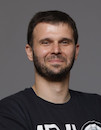Video Communication Technologies
Data is displayed for academic year: 2023./2024.
Lecturers
Exercises
Laboratory exercises
Course Description
Overview of video communication systems and services. Scanning process, conversion of optical images into video signal. Conventional scanning standards, resolution concept, spectrum of video signal. Video signal components. Characteristics of human visual system, visual acuity, eye sensitivity curve, color matching functions, chromaticity diagram. Chrominance signal. Audio signal. Analog-to-digital conversion, component video standards. Video signal compression methods, compression standards, transport stream formatting and multiplexing. Error resilience video coding techniques, error detection, correction and concealment. Broadcasting standards and frequency ranges. Television broadcasting systems, satellite and cable television. Video streaming over Internet, IPTV. Video transmission in mobile systems.
Study Programmes
University graduate
[FER3-HR] Audio Technologies and Electroacoustics - profile
Elective Courses
(1. semester)
Elective Courses of the Profile
(1. semester)
[FER3-HR] Communication and Space Technologies - profile
(3. semester)
[FER3-HR] Computational Modelling in Engineering - profile
Elective Courses
(1. semester)
(3. semester)
[FER3-HR] Computer Engineering - profile
Elective Courses
(1. semester)
(3. semester)
[FER3-HR] Computer Science - profile
Elective Courses
(1. semester)
(3. semester)
[FER3-HR] Control Systems and Robotics - profile
Elective Courses
(1. semester)
(3. semester)
[FER3-HR] Data Science - profile
Elective Courses
(1. semester)
(3. semester)
[FER3-HR] Electrical Power Engineering - profile
Elective Courses
(1. semester)
(3. semester)
[FER3-HR] Electric Machines, Drives and Automation - profile
Elective Courses
(1. semester)
(3. semester)
[FER3-HR] Electronic and Computer Engineering - profile
Elective Courses
(1. semester)
(3. semester)
[FER3-HR] Electronics - profile
Elective Courses
(1. semester)
(3. semester)
[FER3-HR] Information and Communication Engineering - profile
Elective Courses
(1. semester)
(3. semester)
Elective Courses of the Profile
(1. semester)
Elective Coursesof the Profile
(3. semester)
[FER3-HR] Network Science - profile
Elective Courses
(1. semester)
(3. semester)
[FER3-HR] Software Engineering and Information Systems - profile
Elective Courses
(1. semester)
(3. semester)
[FER2-HR] Information Processing - profile
Theoretical Course
(1. semester)
[FER2-HR] Wireless Technologies - profile
Theoretical Course
(1. semester)
Learning Outcomes
- explain image scanning in video camera
- select analog-to-digital conversion parameters for different video signal formats
- calculate bit- rate for different image formats and analog-to-digital conversion parameters
- relate the features of the human visual system and the elements of the video signal compression system
- use spatial and temporal redundancy removal techniques for video signal compression
- modify the parameters of the video signal compression process to different types of communication systems
- predict the effectiveness of error detection and correction methods in of video communication systems
- define quality of service parameters in different types of video communication systems and predict their impact on image quality
Forms of Teaching
Lectures
--
Independent assignments--
Laboratory--
OtherInternship visits
Grading Method
| Continuous Assessment | Exam | |||||
|---|---|---|---|---|---|---|
| Type | Threshold | Percent of Grade | Threshold | Percent of Grade | ||
| Laboratory Exercises | 0 % | 20 % | 0 % | 0 % | ||
| Homeworks | 0 % | 10 % | 0 % | 0 % | ||
| Attendance | 0 % | 5 % | 0 % | 0 % | ||
| Mid Term Exam: Written | 0 % | 25 % | 0 % | |||
| Final Exam: Written | 0 % | 40 % | ||||
| Exam: Written | 50 % | 55 % | ||||
| Exam: Oral | 10 % | |||||
Comment:
--
Week by Week Schedule
- Anatomy of the human eye and visual perception, Light sources; White light; Color as subjective experience, Standard observer and luminosity function
- Contrast sensitivity and visual acuity, Additive mixing of colors; CIE and EBU color primaries
- Color-matching experiment; Unit chromaticity equation; Chromaticity coordinates; Color-mixture curves
- Color spaces and their uses (CIE, RGB, YUV, YIQ, HSL/HSV, and CMYK)
- Scanning standards for SDTV, HDTV and UHDTV, Bit-parallel and bit-serial signal distribution and data multiplexing
- Spatial image formats and digital video specifications, Bit-parallel and bit-serial signal distribution and data multiplexing
- Image and video compression basics
- Midterm exam
- Statistical (spatial and temporal) redundancy; Psychovisual redundancy
- Basic DCT coder and decoder (quantization process, zigzag scanning, RLC and VLC)
- Interframe prediction; Motion compensation; Motion vectors
- Group of pictures; I-, P- and B-frames
- Transport stream formation
- Influence of transmission errors on the decoded video quality
- Final exam
Literature
For students
General
ID 223725
Winter semester
5 ECTS
L2 English Level
L1 e-Learning
45 Lectures
0 Seminar
15 Exercises
16 Laboratory exercises
0 Project laboratory
0 Physical education excercises
Grading System
90 Excellent
78 Very Good
62 Good
50 Sufficient


 Pristupačnost
Pristupačnost
